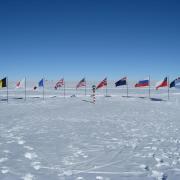Research
This page describes my academic research in experimental cosmology. For my more recent work, see the Data Science page.
I study the Bang in the Big Bang through observations of the cosmic microwave background (CMB). In order to explain numerous present-day observations, cosmologists believe the Universe expanded and evolved from an early hot phase. This theory is called the (hot) "Big Bang." To be consistent with existing data, the hot phase must have been extremely uniform: the variation in temperature from one point to another was 1 part in 10,000. We currently think that inflation, an exponential expansion of space-time, generated these conditions. To test this theory, I am working in a collaboration of scientists searching for signals of inflation in the CMB.
Inflation may be detectable through its effects on the CMB. The CMB is relic radiation released when the Universe became electrically neutral 13 billion years ago. Because of the small variations in temperature at the beginning, there are corresponding small variations in the CMB we observe today. By studying these variations cosmologists create a map of the early Universe and learn how it evolved into the present. The variations are partially polarized (think polarized sunglasses). A major prediction of inflation is that it generated gravitational waves that contributed to the polarization. This is the signal I am trying to measure. It is a very small effect and easily obscured. However, detection of gravitational-wave induced polarization would be compelling evidence for the inflation theory.
I am a member of the QUIET Experiment, which aims to detect a signal from inflation. Some results and more technical details are in my thesis. In 2012 I joined a series of experiments at the South Pole (including BICEP, BICEP2, the Keck Array, and BICEP3) to measure possible inflation signals even more precisely. In March 2014 we reported results from BICEP2 including detection of a polarization signal.


